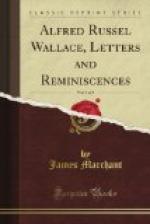My dear Wallace,—I return by this post the Journal.[56] Your resume of glacier action seems to me very good, and has interested my brother much, and as the subject is new to him he is a better judge. That is quite a new and perplexing point which you specify about the freshwater fishes during the glacial period.
I have also been very glad to see the article on Lyell, which seems to me to be done by some good man.
I forgot to say when with you—but I then indeed did not know so much as I do now—that the sexual, i.e. ornamental, differences in fishes, which differences are sometimes very great, offer a difficulty in the wide extension of the view that the female is not brightly coloured on account of the danger which she would incur in the propagation of the species.
I very much enjoyed my long conversation with you; and to-day we return home, and I to my horrid dull work of correcting proof-sheets.—Believe me, my dear Wallace, yours very sincerely,
CHARLES DARWIN.
P.S.—I had arranged to go and see your collection on Saturday evening, but my head suddenly failed after luncheon, and I was forced to lie down all the rest of the day.
* * * * *
Down, Bromley, Kent, S.E. February 23, 1867.
Dear Wallace,—I much regretted that I was unable to call on you, but after Monday I was unable even to leave the house. On Monday evening I called on Bates and put a difficulty before him, which he could not answer, and, as on some former similar occasion, his first suggestion was, “You had better ask Wallace.” My difficulty is, why are caterpillars sometimes so beautifully and artistically coloured? Seeing that many are coloured to escape danger, I can hardly attribute their bright colour in other cases to mere physical conditions. Bates says the most gaudy caterpillar he ever saw in Amazonia (of a Sphinx) was conspicuous at the distance of yards from its black and red colouring whilst feeding on large green leaves. If anyone objected to male butterflies having been made beautiful by sexual selection, and asked why should they not have been made beautiful as well as their caterpillars, what would you answer? I could not answer, but should maintain my ground. Will you think over this, and some time, either by letter or when we meet, tell me what you think? Also, I want to know whether your female mimetic butterfly is more beautiful and brighter than the male?
When next in London I must get you to show me your Kingfishers.
My health is a dreadful evil; I failed in half my engagements during this last visit to London.—Believe me, yours very sincerely,
C. DARWIN.
* * * * *
The answer to this letter is missing, but in Vol. II. of “My Life,” p. 3, Wallace writes:




